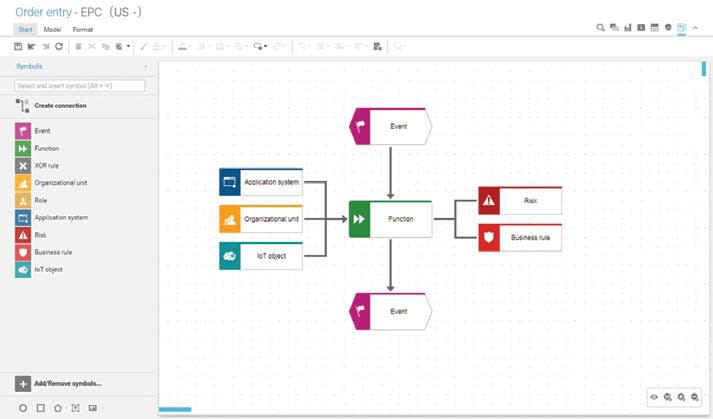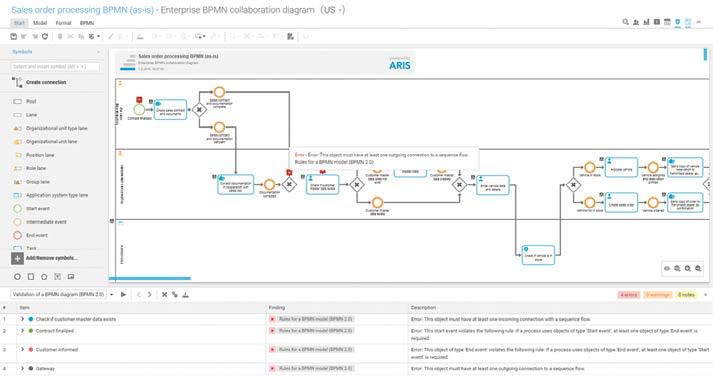Roll out design standards with ARIS
Learn how ARIS helps you reach and consistently ensure an excellent quality of your business concept by rolling out design standards across your organization.
| Issue 3, 2018 |  Download PDF Download PDF |
|---|
Documenting how businesses operate, how they’re organized and how different business perspectives interrelate to each other is one of the core use cases of ARIS. Documenting processes not only serves as a business blueprint but also delivers a reliable basis for analyzing interdependencies on both conceptual and operational levels. It is used as a foundation for process automation, e.g., in terms of implementing software robots (Robotic Process Automation – RPA) or specific IT services. It is also a critical instrument for communicating best-practice knowledge to all employees of an organization. In short, using ARIS to create an Enterprise Digital Twin, the logical result of a mature and high-functioning business design with real-world application, is a key driver for a successful digital transformation.
Reaching high maturity and quality of the business concept during design is often challenging. All of the different application scenarios imply specific requirements regarding “what” and “how” should be modeled and “which” additional information need to be provided and maintained. Three specific examples are:
- GDPR compliance: One of the first steps toward being compliant with the General Data Protection Regulation (GDPR) is the identification and documentation of all activities that process personal data of customers. Such “processing activities” are marked via a specific ARIS attribute. According to the GDPR, all of those activities require a responsibility and a corresponding risk assessment, which might be maintained again via an attribute or satellite objects, such as an organization unit, a role or a risk. For compliance reasons, it is necessary to ensure that all that information is maintained, otherwise an organization runs into the risk of painful penalties of up to €20 million or 4 percent of the global revenue.
- Process automation: Blueprints for processes that are intended to be automated are often described as BPMN™ 2.0 processes or collaboration models. The ability to re-use them in workflow implementation and execution engines requires structural and syntactical correctness with regard to the standard as well as a substantial correctness and consistency to ensure the understandability for the technical counterparts. This, for example, includes the existence of start and end events, the uninterruptability of the process and the consistent definition of gateways.
- Knowledge distribution: The communication of (process) knowledge to all employees of an organization automatically flows into discussions on how that knowledge should be visualized. From a modeling perspective, symbols and colors should be used in order to maintain corporate identity. From a content perspective, it is often desired to maintain additional textual or visual (graphics, videos) descriptions for models, activities or arbitrary objects, which are also covered.
These examples show a variety of requirements ranging from content completeness of syntax and semantics to the visual representation, typically translated into design standards. These design standards can be defined in ARIS and now also rolled out across all process designers and all design clients ( ARIS Connect Designer, ARIS Designer, ARIS Architect ). Three aspects are of major importance: (1) a global definition of individual default templates; (2) an active and automated modeling support; and (3) intelligent checks against individual modeling conventions.
Read on to see how ARIS supports you in achieving this.
Global definition of individual default templates
Modeling templates define the appearance of modeling content in terms of the used symbols, the styling of connections, the positioning of attributes or the background of a model. A set
of templates is already provided by ARIS itself but templates can also be individually designed or adapted to the individual corporate identity of an organization. Templates can be centrally managed and assigned to different model types, thus rolled out as a standard for all modelers and across all design clients.

Fig 1: Centrally managed templates for all design clients
This feature ensures a consistent "look and feel" independent of the designer, which improves the quality of the resulting process landscape and also significantly increases the acceptance and satisfaction of end users since they are familiar with what they see.
Active & automated design support
In many situations, manual modeling effort can be reduced by automation. Regarding the previous examples, the data protection officer could be automatically assigned as a responsible person to all processing activities (activities that process personal data of customers). In other situations, objects or models are serially numbered via specific attributes. These are only two examples, where automatic routines , i.e., reports, could automatically do recurring design work instead of the designer. This does not only reduce the individual work load but also the risk of errors.

Fig 2: Design standards via automatic routines
Since models are often a basis for further application scenarios, the automation capabilities (i.e., macros) might also be used for updating consecutive documents, such as RACI charts, process manuals or job descriptions, whenever a new version of a model is saved.
Intelligent checks against individual modeling conventions
Design standards (respectively modeling conventions) can be defined as rules in ARIS. This includes the existence, allocation or assignments of modeling assets, the maintenance of specific attributes following a predefined structure and much more. Many rules are already predefined and logically grouped regarding important application scenarios in ARIS. But they can also be flexibly defined to cover the requirements in your organization.
Models in the ARIS repository can be checked against rules using the semantic check. A user can choose his application scenario, e.g., modeling a BPMN process, that should be automated in the next step, and ARIS checks whether the process is suitable for a transfer to the development unit or if an adapted process should be part of the next release, for which it has to pass a quality gate that is covered by qualitative rules.

Fig 3: Intelligent semantic check
The user immediately gets a differentiated overview (errors, warnings, hints) on the found issues, which he is able to work on step by step or based on marks within the model. In addition to highlighting identified issues, ARIS delivers concrete descriptions and recommendations on how an issue can be solved. In order to consistently ensure a high quality of the modeling output, the execution of semantic checks can be automated depending on the model type or the designer's role.
ARIS leads to excellence with ease
All in all, a combination of default templates, active modeling support and automation as well as the application of semantic checks leads to high-quality, exceptional business practices.
- Save time and effort by automating recurring manual design work
- Ensure high quality by only releasing business knowledge that has passed a quality gate
- Win end-user acceptance and satisfaction in a consistent and easy-to-consume "look and feel"
- Be compliant with legal regulations such as the GDPR, specific industry standards and your own business standards
- Be prepared for all relevant application scenarios, such as scenario planning, (robotic) process automation or process- driven management of SAP® solutions






Top comments (0)